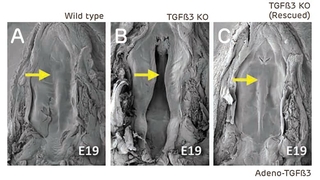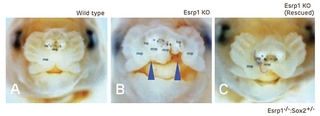Cleft lip and/or palate is a developmental defect resulting from a failure of the mesial nasal process to fuse with the lateral nasal process and/or the maxillary process. This seemingly simple fusion failure is consequential, leading to significant structural deformities and functional deficits. Prenatal correction of cleft lip and/or palate would offer benefits that are not attainable through conventional postnatal treatment.
Using a Tgfß3−/− mouse model, which displays complete penetrance of the cleft palate phenotype, we have demonstrated that intra-amniotic delivery of the Tgfß3 gene restores epithelial function of the palatal shelves and allows recapitulation of the normal palatal fusion process in embryos (figure 1). This rescue only required transduction of the transient peridermal cell layer, suggesting that certain cleft palate cases may be treated in utero by targeting peridermal cells for gene transfer. This study was the first demonstration that a developmental anatomical defect can be corrected in utero with intra-amniotic gene transfer.1

We are also investigating additional molecular targets for in utero rescue of cleft lip. For this study, we are using a novel Esrp1-/- mouse model, in which the cleft lip and palate phenotype is fully penetrant. Esrp1 encodes a protein necessary for epithelial specific RNA splicing, and thus the Esrp1-/- is expected to cause dysfunction of epithelium development. Our data show that the cleft lip phenotype of Esrp1-/- mice can be rescued by reducing Sox2 gene dosage (figure 2). We are currently working to delineate the molecular and genetic pathways responsible for the rescue of cleft lip formation.

Reference
1. Intra-amniotic transient transduction of the periderm with a viral vector encoding TGFß3 prevents cleft palate in Tgfß3−/− mouse embryos. Mol Ther. 21(1):8-17.
Featured in this article
Specialties & Programs
Cleft lip and/or palate is a developmental defect resulting from a failure of the mesial nasal process to fuse with the lateral nasal process and/or the maxillary process. This seemingly simple fusion failure is consequential, leading to significant structural deformities and functional deficits. Prenatal correction of cleft lip and/or palate would offer benefits that are not attainable through conventional postnatal treatment.
Using a Tgfß3−/− mouse model, which displays complete penetrance of the cleft palate phenotype, we have demonstrated that intra-amniotic delivery of the Tgfß3 gene restores epithelial function of the palatal shelves and allows recapitulation of the normal palatal fusion process in embryos (figure 1). This rescue only required transduction of the transient peridermal cell layer, suggesting that certain cleft palate cases may be treated in utero by targeting peridermal cells for gene transfer. This study was the first demonstration that a developmental anatomical defect can be corrected in utero with intra-amniotic gene transfer.1

We are also investigating additional molecular targets for in utero rescue of cleft lip. For this study, we are using a novel Esrp1-/- mouse model, in which the cleft lip and palate phenotype is fully penetrant. Esrp1 encodes a protein necessary for epithelial specific RNA splicing, and thus the Esrp1-/- is expected to cause dysfunction of epithelium development. Our data show that the cleft lip phenotype of Esrp1-/- mice can be rescued by reducing Sox2 gene dosage (figure 2). We are currently working to delineate the molecular and genetic pathways responsible for the rescue of cleft lip formation.

Reference
1. Intra-amniotic transient transduction of the periderm with a viral vector encoding TGFß3 prevents cleft palate in Tgfß3−/− mouse embryos. Mol Ther. 21(1):8-17.
Contact us
Cleft Lip and Palate Program